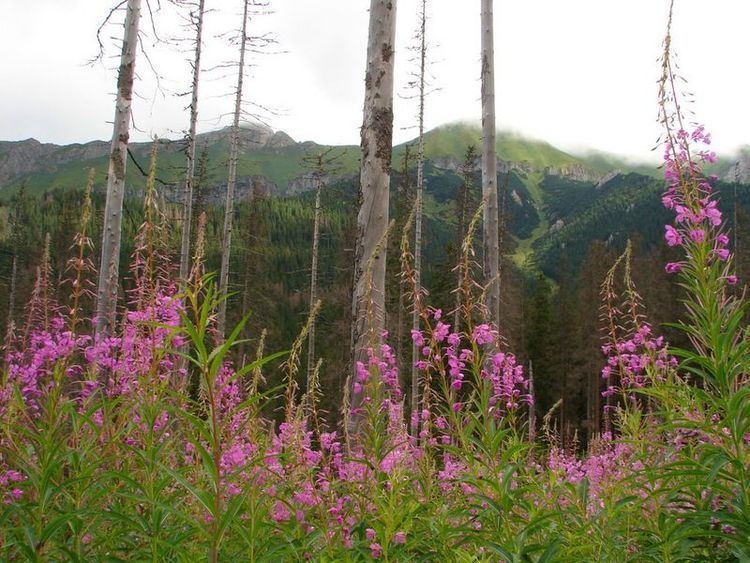Woodland /ˈwʊdlənd/ is a low-density forest forming open habitats with plenty of sunlight and limited shade. Woodlands may support an understory of shrubs and herbaceous plants including grasses. Woodland may form a transition to shrubland under drier conditions or during early stages of primary or secondary succession. Higher density areas of trees with a largely closed canopy that provides extensive and nearly continuous shade are referred to as forests.
Conservationists have worked hard to preserve woodlands, because people are destroying animals habitats when building homes and other buildings. For example, the woodlands in Northwest Indiana have been preserved as part of the Indiana Dunes.
Woodland is used in British woodland management to mean tree-covered areas which arose naturally and which are then managed, while forest is usually used in the British Isles to describe plantations, usually more extensive, or hunting Forests, which are a land use with a legal definition and may not be wooded at all. The term "ancient woodland" is used in British nature conservation to refer to any wooded land that has existed since 1600, and often (though not always) for thousands of years, since the last Ice Age (equivalent to the American term old-growth forest).
Woodlot is a closely related American term, which refers to a stand of trees generally used for firewood. While woodlots often technically have closed canopies, they are so small that light penetration from the edge makes them ecologically closer to woodland than forest.
In Australia, a woodland is defined as an area with sparse (10-30%) cover of trees, and an open woodland has very sparse (<10%) cover. Woodlands are also subdivided into tall woodlands, or low woodlands, if their trees are over 30 m or under 10 m high respectively. This contrasts with forests, which have greater than 30% cover by trees.
Tropical and subtropical grasslands, savannas, and shrublands
Afrotropic ecozoneAngolan Miombo woodlands (Angola)Angolan Mopane woodlands (Angola, Namibia)Central Zambezian Miombo woodlands (Angola, Burundi, Democratic Republic of the Congo, Malawi, Tanzania, Zambia)Eastern Miombo woodlands (Mozambique, Tanzania)Kalahari Acacia-Baikiaea woodlands (Botswana, Namibia, South Africa, Zimbabwe)Zambezian and Mopane woodlands (Botswana, Malawi, Mozambique, Namibia, South Africa, Swaziland, Zambia, Zimbabwe)Zambezian Baikiaea woodlands (Angola, Botswana, Namibia, Zambia, Zimbabwe)Neotropic ecozoneCerrado woodlands and savannas (Bolivia, Brazil, Paraguay)Temperate grasslands, savannas, and shrublands
Afrotropic EcozoneAl Hajar Al Gharbi montane woodlands (Oman)Palearctic ecozoneGissaro-Alai open woodlands (Kyrgyzstan, Tajikistan, Uzbekistan)Montane grasslands and shrublands
Afrotropic ecozoneAngolan Scarp savanna and woodlands (Angola)Drakensberg alti-montane grasslands and woodlands (Lesotho, South Africa)Drakensberg montane grasslands, woodlands and forests (Lesotho, South Africa, Swaziland)East African montane moorlands (Kenya, Sudan, Tanzania, Uganda)Ethiopian montane grasslands and woodlands (Ethiopia)Palearctic ecozoneKopet Dag woodlands and forest steppe (Iran, Turkmenistan)Mediterranean forests, woodlands, and scrub
Australasia ecozoneCoolgardie woodlands (Australia)Mount Lofty woodlands (Australia)Murray-Darling woodlands and mallee (Australia)Naracoorte woodlands (Australia)Southwest Australia woodlands (Australia)Nearctic ecozoneCalifornia chaparral and woodlands (United States)Palearctic ecozoneBaccanico (berrywood) an area with a high density of all sorts of berry ("berry" in Italian "bacca") trees.Canary Islands dry woodlands and forests (Spain)Mediterranean acacia-argania dry woodlands and succulent thickets (Morocco, Canary Islands (Spain))Mediterranean dry woodlands and steppe (Algeria, Egypt, Libya, Morocco, Tunisia)Mediterranean woodlands and forests (Algeria, Morocco, Tunisia)Southeastern Iberian shrubs and woodlands (Spain)Deserts and xeric shrublands
Afrotropic ecozoneEast Saharan montane xeric woodlands (Chad, Sudan)Madagascar succulent woodlands (Madagascar)Somali montane xeric woodlands (Somalia)Southwestern Arabian montane woodlands (Saudi Arabia, Yemen)Palearctic ecozoneBaluchistan xeric woodlands (Afghanistan, Pakistan)Central Afghan Mountains xeric woodlands (Afghanistan)Central Asian riparian woodlands (Kazakhstan)North Saharan steppe and woodlands (Algeria, Egypt, Libya, Morocco Tunisia, Western Sahara)Paropamisus xeric woodlands (Afghanistan)South Saharan steppe and woodlands (Algeria, Chad, Mali, Mauritania, Niger, Sudan)Tibesti-Jebel Uweinat montane xeric woodlands (Chad, Egypt, Libya, Sudan)West Saharan montane xeric woodlands (Algeria, Mali, Mauritania, Niger)
